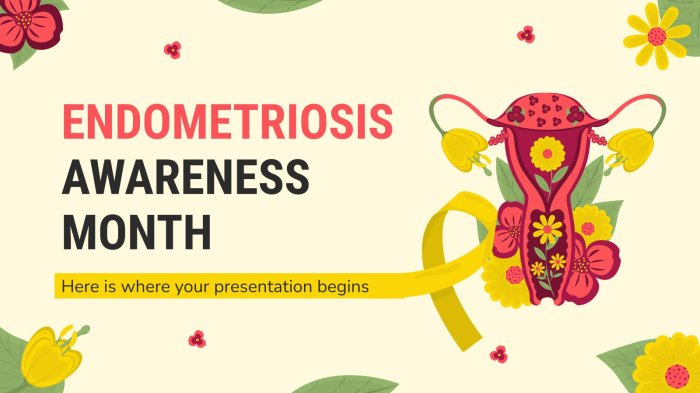
Endometriosis Awareness isn’t just about knowing the facts; it’s about understanding the profound impact this often-misunderstood condition has on millions of women worldwide. We’re diving deep into the world of endometriosis, exploring its biological roots, its varied symptoms, and the challenges women face in diagnosis and treatment. Prepare to be informed, empowered, and maybe even a little surprised by what we uncover!
From the frustrating diagnostic odyssey to the emotional toll of chronic pain and potential fertility issues, we’ll examine the multifaceted nature of endometriosis. We’ll also explore the crucial role of advocacy and research in improving the lives of those affected, highlighting inspiring stories of resilience and hope along the way. Get ready to join the conversation and become a champion for endometriosis awareness!
Defining Endometriosis
Endometriosis is a chronic condition affecting millions of women worldwide. It’s characterized by the growth of tissue similar to the lining of the uterus (the endometrium) in locations outside the uterus. This misplaced tissue responds to hormonal changes, leading to inflammation, pain, and other complications. Understanding its biological mechanisms, diverse presentations, and associated symptoms is crucial for effective management and support.
Endometriosis: Biological Mechanisms
The exact cause of endometriosis remains unknown, but several theories exist. Retrograde menstruation, where menstrual blood flows back through the fallopian tubes into the pelvic cavity, is a leading hypothesis. Immune system dysfunction may also play a role, failing to recognize and eliminate endometrial cells that have migrated outside the uterus. Another theory suggests that endometrial cells may spread through the lymphatic system or bloodstream.
Genetic predisposition is also being investigated as a contributing factor. Hormonal imbalances, particularly elevated estrogen levels, can stimulate the growth and proliferation of ectopic endometrial tissue. The inflammatory response triggered by this ectopic tissue contributes significantly to the pain and other symptoms experienced by individuals with endometriosis.
Types and Classifications of Endometriosis
Endometriosis is classified based on several factors, primarily the location and extent of the lesions. The most common classification system uses stages, ranging from minimal to severe, based on the amount and depth of endometrial implants. These stages are often determined during laparoscopic surgery, where a surgeon directly visualizes the affected areas. Lesions can be found on various organs, including the ovaries, fallopian tubes, bowel, and bladder.
They can range from small, superficial implants to large, deep infiltrating endometriosis (DIE), which can cause significant organ involvement and complications. Specific types include peritoneal endometriosis (on the outer surface of the pelvic organs), ovarian endometriosis (forming endometriomas or “chocolate cysts”), and deep infiltrating endometriosis (affecting deeper tissues).
Symptoms of Endometriosis
The symptoms of endometriosis are highly variable and can range from mild to severe. Many individuals experience chronic pelvic pain, often worsening during menstruation. This pain can radiate to the lower back, legs, or abdomen. Heavy menstrual bleeding (menorrhagia) and prolonged menstrual periods (menometrorrhagia) are also common. Painful intercourse (dyspareunia) and painful bowel movements or urination (dyschezia and dysuria, respectively) can occur.
Infertility is a significant concern for many women with endometriosis, as the condition can interfere with ovulation and implantation. Other symptoms may include fatigue, bloating, nausea, and digestive problems. It’s important to note that the severity of symptoms does not always correlate with the stage of the disease.
Comparison of Endometriosis Symptoms with Other Conditions
| Symptom | Endometriosis | Irritable Bowel Syndrome (IBS) | Pelvic Inflammatory Disease (PID) |
|---|---|---|---|
| Pelvic Pain | Chronic, cyclical, can radiate | Intermittent, cramping, bloating | Sharp, severe, fever |
| Menstrual Changes | Heavy bleeding, prolonged periods | Often unrelated to menses | Abnormal bleeding, potentially absent |
| Bowel/Bladder Symptoms | Painful bowel movements/urination | Diarrhea, constipation, bloating | Painful urination, frequent urination |
| Infertility | Common complication | Not directly linked | Significant risk |
Diagnosis and Treatment of Endometriosis
Diagnosing and treating endometriosis can be a challenging journey for many women. The insidious nature of the disease, coupled with the lack of a single definitive diagnostic test, often leads to significant delays in diagnosis and appropriate management. Understanding the diagnostic process and available treatment options is crucial for effective patient care.
Diagnostic Challenges and Methods
The difficulty in diagnosing endometriosis stems from its varied presentations and the absence of a specific biomarker. Symptoms, such as chronic pelvic pain, heavy menstrual bleeding, and infertility, are often nonspecific and can be attributed to other conditions. Therefore, a multi-pronged approach is typically necessary. This involves a combination of patient history, physical examination, and imaging techniques, sometimes culminating in laparoscopy for definitive diagnosis.
- Patient History: A thorough review of the patient’s menstrual history, including the onset of menstruation, cycle regularity, pain levels, and associated symptoms, is paramount. The physician will also inquire about any family history of endometriosis or other reproductive conditions.
- Pelvic Examination: A physical examination may reveal tenderness or abnormalities in the pelvic region, though these findings are not always conclusive. The examination may reveal palpable nodules or tenderness indicative of endometriosis, but it does not provide a definitive diagnosis.
- Imaging Techniques: Transvaginal ultrasound (TVUS) is a commonly used imaging modality. It can sometimes identify endometrial implants, but its sensitivity and specificity are limited. Magnetic resonance imaging (MRI) offers better visualization of deep infiltrating endometriosis, but it’s not always readily available or cost-effective.
- Laparoscopy: Laparoscopic surgery is considered the gold standard for diagnosing endometriosis. During this minimally invasive procedure, a surgeon inserts a small camera into the abdomen to directly visualize the pelvic organs and identify endometrial implants. A biopsy can be taken to confirm the diagnosis.
Treatment Options for Endometriosis
Treatment for endometriosis is individualized and depends on the severity of symptoms, the patient’s age, and her reproductive desires. The primary goals of treatment are to alleviate pain, improve fertility, and manage the disease’s progression. Treatment options range from medical management to surgical intervention.
Medical Management of Endometriosis
Medical treatments aim to suppress the production of estrogen, thereby reducing the growth and activity of endometrial implants.
- Hormonal Therapy: This is often the first-line treatment for endometriosis and involves medications such as combined oral contraceptives (COCs), progestins, GnRH agonists/antagonists, and danazol. COCs regulate the menstrual cycle, reducing the amount of endometrial tissue shed. Progestins suppress ovulation. GnRH agonists temporarily suppress ovarian function, leading to a significant reduction in estrogen levels. Danazol is a synthetic steroid that suppresses ovulation and reduces endometrial tissue growth.
Each has its own side effect profile, including mood changes, weight gain, and decreased bone density (especially with GnRH agonists).
- Nonsteroidal Anti-inflammatory Drugs (NSAIDs): NSAIDs, such as ibuprofen or naproxen, can help manage pain associated with endometriosis by reducing inflammation. However, they do not address the underlying disease.
Surgical Management of Endometriosis
Surgical treatment may be necessary when medical management fails to provide adequate pain relief or when fertility is affected.
- Laparoscopic Surgery: This minimally invasive procedure allows for the removal or destruction of endometrial implants. It can improve pain and fertility outcomes.
- Hysterectomy and Bilateral Salpingo-Oophorectomy (BSO): This is a more extensive surgery involving the removal of the uterus, fallopian tubes, and ovaries. It’s typically considered as a last resort for severe endometriosis that does not respond to other treatments. It effectively eliminates the source of estrogen production and, therefore, the growth of endometrial tissue.
Comparison of Treatment Effectiveness and Side Effects
The effectiveness and side effects of endometriosis treatments vary widely depending on the individual and the specific treatment chosen. Hormonal therapies are generally well-tolerated, but side effects such as mood changes, weight gain, and decreased libido are common. Surgical interventions can be highly effective in relieving pain and improving fertility, but they carry risks associated with any surgery, including infection and complications.
The choice of treatment should be made in consultation with a healthcare professional after careful consideration of the individual’s circumstances and preferences.
Infographic: Diagnostic Pathway for Endometriosis
The infographic would depict a flowchart. It begins with “Suspected Endometriosis” (based on symptoms like chronic pelvic pain, heavy bleeding, infertility). This leads to a branching pathway:* Branch 1: Initial Assessment: This includes a detailed patient history, focusing on menstrual cycle details, pain characteristics, and family history. A pelvic exam is also conducted, looking for tenderness or abnormalities. This box connects to the next stage.* Branch 2: Imaging: This box details the use of transvaginal ultrasound (TVUS) as a first-line imaging modality.
The limitations of TVUS are mentioned (low sensitivity and specificity). A separate path leads to MRI as a possible next step for suspected deep infiltrating endometriosis. Both pathways lead to the next stage.* Branch 3: Laparoscopy: This is the gold standard for diagnosis, depicted as the central pathway. It involves a minimally invasive surgical procedure allowing direct visualization of the pelvic organs and collection of tissue samples for biopsy confirmation.
A positive biopsy confirms the diagnosis of endometriosis. A negative biopsy does not rule out the disease, and further investigation may be needed. The end point is “Endometriosis Diagnosed” or “Further Investigation Needed.”The infographic would visually represent the sequential steps involved in reaching a diagnosis, highlighting the role of each diagnostic method and the potential for further investigations based on initial findings.
The visual representation of the pathway would make it easy to understand the diagnostic process and its complexities.
Impact of Endometriosis on Women’s Lives

Endometriosis significantly impacts the lives of millions of women worldwide, extending far beyond the physical pain. The condition’s effects ripple through daily routines, relationships, and overall well-being, creating a complex tapestry of challenges that demand understanding and support. This section explores the multifaceted impact of endometriosis on women’s lives, highlighting personal experiences, psychological consequences, reproductive implications, and the key challenges faced.
Personal Stories Illustrating the Impact of Endometriosis on Daily Life
Endometriosis doesn’t simply cause pain; it dictates life. One woman described her experience as a constant battle against fatigue, where even simple tasks like showering or climbing stairs felt like insurmountable feats. Another recounted the debilitating pain that would unexpectedly strike, forcing her to cancel plans and retreat to bed, impacting her social life and career. A third shared how the unpredictable nature of her symptoms made it impossible to plan anything, leaving her feeling constantly anxious and uncertain about her future.
These are just a few examples of the profound ways endometriosis can disrupt daily life, limiting participation in work, social events, and even basic self-care.
Psychological and Emotional Effects of Living with Endometriosis
The chronic pain and unpredictable nature of endometriosis contribute significantly to a range of psychological and emotional challenges. Many women experience depression, anxiety, and feelings of isolation. The constant struggle to manage pain and navigate healthcare systems can lead to feelings of helplessness and frustration. The impact on self-esteem is also considerable, with some women reporting a diminished sense of self-worth and body image issues.
The emotional toll can be immense, affecting relationships, work productivity, and overall quality of life. Many women feel misunderstood, leading to feelings of loneliness and isolation.
Impact of Endometriosis on Fertility and Reproductive Health
Endometriosis can significantly impact fertility and reproductive health. The presence of endometrial tissue outside the uterus can interfere with ovulation, fertilization, and implantation. Scarring and inflammation caused by endometriosis can also obstruct fallopian tubes, making it difficult for sperm to reach the egg or for a fertilized egg to reach the uterus. Many women with endometriosis experience difficulty conceiving, requiring assisted reproductive technologies such as IVF.
Even with treatment, pregnancy may still be challenging. The emotional distress associated with infertility adds another layer of complexity to the already difficult journey of living with endometriosis.
Key Challenges Faced by Women with Endometriosis
The challenges faced by women with endometriosis are numerous and interconnected. A comprehensive understanding of these challenges is crucial for developing effective support systems and improving the lives of affected women.
- Chronic Pain Management: Finding effective pain management strategies that alleviate symptoms without significant side effects remains a significant hurdle for many women.
- Diagnostic Delays: The long and often arduous diagnostic process, characterized by multiple doctor visits and invasive procedures, contributes significantly to stress and frustration.
- Treatment Ineffectiveness: While various treatments are available, their effectiveness varies widely, leaving many women feeling hopeless and without adequate relief.
- Impact on Relationships: The physical and emotional burdens of endometriosis can strain relationships with partners, family, and friends.
- Financial Burden: The cost of diagnosis, treatment, and ongoing management can be substantial, creating a significant financial burden for many women.
- Lack of Awareness and Understanding: The lack of widespread awareness and understanding of endometriosis contributes to delayed diagnosis, inadequate treatment, and feelings of isolation.
Endometriosis Awareness and Advocacy
Raising awareness about endometriosis is crucial for improving the lives of millions of women worldwide. The lack of widespread understanding, both within the medical community and the general public, leads to delayed diagnoses, inadequate treatment, and significant emotional and physical suffering. Effective advocacy is essential to bridge this knowledge gap and ensure that individuals with endometriosis receive the care they deserve.The importance of raising awareness extends beyond individual patient experiences.
Increased awareness can influence healthcare policy, research funding, and the development of improved diagnostic tools and treatments. A more informed public can also provide vital support and understanding to those affected, fostering a more compassionate and supportive environment.
The Role of Patient Advocacy Groups
Patient advocacy groups play a vital role in supporting individuals with endometriosis and driving change. These organizations provide a crucial link between patients, researchers, healthcare professionals, and policymakers. They offer a variety of services, including education, support groups, and resources for navigating the healthcare system. For example, the Endometriosis Foundation of America (EFA) provides extensive educational materials, organizes fundraising events for research, and advocates for policy changes that benefit individuals with endometriosis.
These groups empower patients to become active participants in their own healthcare and contribute to a larger movement for improved diagnosis and treatment. They also conduct vital lobbying efforts to ensure that endometriosis receives the attention and funding it deserves.
Strategies for Effective Communication and Education
Effective communication about endometriosis requires a multi-pronged approach. Clear, accessible information is vital. This includes using plain language, avoiding overly technical medical jargon, and employing various communication channels to reach diverse audiences. Social media campaigns, public awareness events, and partnerships with healthcare providers can all contribute to a more informed public. For instance, utilizing infographics to visually represent complex medical information or creating short, impactful videos explaining the condition can significantly improve understanding.
Collaborations with influencers and celebrities can also increase the reach and impact of awareness campaigns, raising awareness amongst broader demographics.
A Plan for Increasing Public Awareness and Understanding of Endometriosis
A comprehensive plan to increase public awareness and understanding of endometriosis should include several key steps. First, a targeted public awareness campaign utilizing multiple media platforms (social media, print, television, radio) is needed. This campaign should focus on educating the public about the symptoms, diagnosis, and treatment options for endometriosis. Second, we need to develop educational materials for healthcare providers to improve diagnostic accuracy and treatment strategies.
This involves providing continuing medical education (CME) courses and updated clinical guidelines. Third, we must actively engage policymakers to advocate for increased research funding and improved access to care. This includes lobbying efforts and collaborations with relevant government agencies. Finally, support networks and community building for patients and their families are crucial. This includes the establishment of support groups, online forums, and other resources to provide emotional support and practical guidance.
The successful implementation of such a plan would significantly improve the lives of those affected by endometriosis.
Women & Health

Understanding endometriosis requires acknowledging its place within the broader landscape of women’s health. Women face unique challenges in healthcare access, diagnosis, and treatment, often experiencing disparities compared to their male counterparts. Endometriosis, with its often-delayed diagnosis and complex management, exemplifies many of these broader issues.Women’s health encompasses a wide spectrum of physical and mental well-being, influenced by hormonal changes, reproductive health, and societal factors.
This complexity necessitates a holistic approach to healthcare, considering the interconnectedness of various aspects of a woman’s life. Ignoring this interconnectedness can lead to inadequate treatment and management of conditions like endometriosis.
Healthcare Experiences: Endometriosis vs. General Women’s Health
Women with endometriosis frequently report significantly longer diagnostic delays compared to women seeking treatment for other conditions. The subjective nature of symptoms, often dismissed as “normal period pain,” contributes to this delay. Furthermore, the lack of readily available, accessible, and affordable diagnostic tools and specialist expertise exacerbates the problem. In contrast, women experiencing other health issues may receive prompt diagnosis and treatment, highlighting a critical disparity in healthcare access and quality.
This difference underscores the need for improved education and awareness among healthcare providers regarding endometriosis symptoms and diagnostic pathways.
Comprehensive Healthcare for Women
Comprehensive healthcare for women necessitates a proactive, preventative, and personalized approach. This means regular check-ups tailored to different life stages, addressing reproductive health, mental health, and chronic conditions. For women with endometriosis, this comprehensive care might involve a multidisciplinary team including gynecologists, pain specialists, and mental health professionals. Access to affordable and accessible diagnostic testing, effective pain management strategies, and fertility preservation options are crucial components of this comprehensive approach.
Regular screenings for related conditions, such as ovarian cancer, are also vital.
Societal Influences on Endometriosis Healthcare
Societal factors significantly impact women’s access to healthcare and treatment for endometriosis. These factors include socioeconomic status, geographical location, insurance coverage, and cultural beliefs. Women from lower socioeconomic backgrounds may face barriers to accessing specialized care due to financial constraints and limited access to healthcare facilities. Similarly, geographical location can influence access to specialists and advanced diagnostic technologies.
Insurance coverage plays a critical role in determining affordability of treatment and diagnostic tests. Finally, societal attitudes towards women’s pain and reproductive health can lead to dismissal of symptoms and delays in diagnosis. For example, a woman in a rural area with limited access to specialists may experience a significantly longer diagnostic journey than a woman living in a metropolitan area with readily available healthcare resources.
Research and Future Directions
The fight against endometriosis is far from over, and significant advancements are being made through ongoing research and the development of innovative treatments. Understanding the complexities of this disease requires a multi-faceted approach, encompassing basic science, clinical trials, and technological innovation. This ongoing work holds the promise of significantly improving the lives of millions of women affected by endometriosis.
Current research focuses on several key areas, aiming to unravel the disease’s underlying mechanisms, improve diagnostic accuracy, and develop more effective and less invasive treatments. This includes investigations into genetic predispositions, immune system involvement, and the role of environmental factors. The ultimate goal is to develop personalized treatments tailored to individual patient needs and disease severity.
Current Areas of Endometriosis Research
Research into endometriosis is progressing on multiple fronts. Scientists are investigating the genetic factors that contribute to the development of the disease, identifying specific genes and gene variations associated with increased risk. This work may lead to genetic screening tools to identify individuals at higher risk, enabling earlier diagnosis and intervention. Furthermore, studies are exploring the complex interplay between the immune system and endometriosis, examining how immune cells contribute to the disease process and identifying potential therapeutic targets.
Finally, research is also investigating the potential role of environmental factors, such as exposure to endocrine-disrupting chemicals, in increasing the risk of endometriosis.
Promising New Treatment Approaches
Several promising new treatment approaches are under development. These include novel drug therapies targeting specific molecular pathways involved in the disease process, such as those affecting inflammation and tissue growth. Researchers are also exploring minimally invasive surgical techniques, including robotic surgery, which offers greater precision and potentially reduced complications compared to traditional open surgery. Furthermore, regenerative medicine approaches, such as stem cell therapy, are showing potential for repairing damaged tissues and reducing the severity of endometriosis symptoms.
For example, ongoing trials are investigating the use of mesenchymal stem cells to reduce inflammation and scarring in the pelvic region.
Ongoing Clinical Trials and Studies
Numerous clinical trials and studies are currently underway, investigating the efficacy and safety of new treatments for endometriosis. These trials range from phase I studies evaluating the safety of new drugs in humans to phase III studies comparing new treatments to existing therapies. Information on these trials is readily available through clinicaltrials.gov and other similar databases. Examples include trials exploring the effectiveness of novel pain management strategies, immunotherapies, and hormonal therapies.
These trials aim to improve treatment outcomes, reduce side effects, and provide more effective long-term management of the disease.
Timeline of Significant Milestones in Endometriosis Research
While the understanding of endometriosis has evolved over time, several key milestones have significantly advanced the field. A comprehensive timeline would include the following:
| Year | Milestone | Significance |
|---|---|---|
| 1860 | First documented description of endometriosis by Carl von Rokitansky. | Established the basic clinical understanding of the disease. |
| 1920s-1930s | Early surgical techniques developed for treating endometriosis. | Improved treatment options, although often invasive. |
| 1980s-Present | Increased research into the pathogenesis of endometriosis. | Led to better understanding of the underlying mechanisms and potential therapeutic targets. |
| Present | Development of novel drug therapies and minimally invasive surgical techniques. | Offers improved treatment options with reduced side effects and improved patient outcomes. |
Outcome Summary
Understanding endometriosis is a journey, not a destination. This exploration has hopefully shed light on the complexities of this condition, from its insidious biological mechanisms to the significant impact it has on women’s lives. By raising awareness, fostering open conversations, and supporting ongoing research, we can pave the way for earlier diagnosis, better treatments, and ultimately, a brighter future for everyone affected by endometriosis.
Let’s continue the conversation and empower women to take control of their health!
Top FAQs
Is endometriosis hereditary?
While not directly inherited, a family history of endometriosis increases the risk. Genetic factors play a role, but it’s not a simple case of inheriting the condition.
Can endometriosis be cured?
There’s currently no cure, but treatments effectively manage symptoms and improve quality of life. Surgical removal of endometrial tissue can help, but it might recur.
How common is endometriosis?
It’s estimated that 1 in 10 women of reproductive age have endometriosis, but the actual prevalence might be higher due to underdiagnosis.
What are the long-term effects of endometriosis?
Long-term effects can include chronic pain, infertility, and increased risk of certain cancers. Early diagnosis and management are crucial to mitigate these risks.





